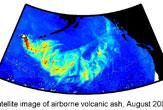
Volcano Blows a Hole in Controversial Geoengineering Idea

A volcanic plume of iron-laden ash from a 2008 Alaskan volcano eruption led to an unprecedentedly huge bloom of photosynthetic ocean plankton that fed off the ash, researchers have found.
This natural phenomenon is much like a geoengineering scenario proposed by some researchers who want to fight global warming by spurring the growth of marine plants that can suck carbon dioxide from the air.
However, this massive bloom of plankton resulted in only a modest uptake of atmospheric carbon dioxide, the researchers said, seemingly dealing another blow to such geoengineering schemes.
Scientists investigated the August 2008 eruption of the Kasatochi volcano in the Aleutian Islands, which spewed iron-laden ash over a 620-mile (1,000-kilometer) swath of the North Pacific some 580,000 to 770,000 square miles (1.5 million to 2 million sq. km) in size.
The result was an "ocean productivity event of unprecedented magnitude," said oceanographer Roberta Hamme at the University of Victoria in Canada. The ash caused the largest bloom of photosynthetic plankton detected in the region since ocean surface measurements by satellite began in 1997 — the first conclusive evidence that volcanic plumes can fertilize oceans.
Photosynthetic plankton, or phytoplankton, are free-floating, single-celled organisms that account for half of all photosynthetic activity on Earth. Since they naturally absorb the global warming gas carbon dioxide, geoengineering advocates have proposed seeding the oceans with iron to help spur their growth. Iron, which acts as a fertilizer for phytoplankton, is rare in the oceans.
Even if people wanted to artificially replicate this event to combat global warming, "it would be essentially impossible," Hamme told OurAmazingPlanet. "What really allowed this ash to hit such a large area was the fact there was a storm system forming over the volcano when it erupted, and the ash got swirled around. Unless you could somehow put vast amounts of iron-containing particles into a storm going in the right direction for you, I think replicating this would be pretty hard to do."
Sign up for the Live Science daily newsletter now
Get the world’s most fascinating discoveries delivered straight to your inbox.
Another problem for replicating this event as a geoengineering scheme, Hamme and her colleagues estimated that this massive plume only absorbed about 4 million tons (37 billion kg) of carbon dioxide. While this might sound like a lot, the burning of fossil fuels releases nearly 7,000 times as much carbon dioxide annually at about 26.4 billion tons (24 trillion kg) a year, while the oceans naturally absorb about 8.1 billion tons (7.4 trillion kg) of carbon dioxide annually.
"Despite the huge area of iron addition and the optimal time of year when there was plenty of sunlight, the impact of this August 2008 event in terms of carbon dioxide absorption was quite small," Hamme said. "This tells us that iron fertilization would have to be performed on a truly gigantic scale to have an impact on our climate."
Hamme also suggested that one might not want to rely on volcanoes to fight global warming. "Volcanoes release carbon dioxide as well," she said. "In the end, there might be a net zero effect."
Hamme and her colleagues detailed their findings online Oct. 5 in the journal Geophysical Research Letters.
- Image Gallery: Volcanoes from Space
- Top 10 Craziest Environmental Ideas
- 10 Wild Volcano Facts
This article was provided by OurAmazingPlanet, a sister site of LiveScience.












